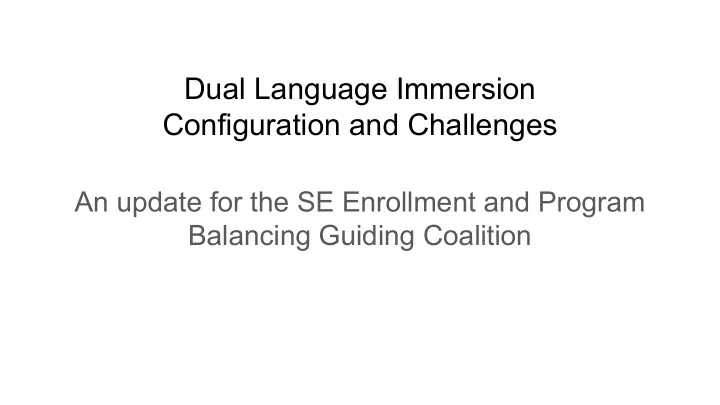

Dual Language Immersion Configuration and Challenges An update for the SE Enrollment and Program Balancing Guiding Coalition
DLI Overview ● 16 DLI Pathways across 5 languages ● Over 5,800 students in K-12 ● 14% of Kindergarteners ● 46% of Kinder ELLs ● Recent research demonstrates success for underserved populations ○ 7 mo ahead in English Language Arts by 5th grade ○ 9 mo ahead in English Language Arts by 8th grade ○ 14 percentage points higher ELL reclassification rates by 6th grade for speakers of partner language ○
DLI Program Configurations Defined 4 Types of K-5/K-8 configurations district-wide, depending on ratio of English Scholar (ES) strands to DLI Scholar strands Configuration Type Preferences and Challenges (#schools) Balanced-equal English Scholar (ES) and DLI Preferred co-location configuration (4) sections More ES than Immersion Present challenges for DLI side (6) More Immersion than ES Present significant challenges for ES side (4) All Immersion Greatest opportunity for instructional focus (2)
DLI Configurations in SE Schools Configuration Schools Balanced Kelly, Woodstock More English Scholar (ES) than Immersion Atkinson, Harrison Park, Lent More Immersion than ES Bridger All Immersion Richmond District-wide program configurations
Challenges of Co-location with single ES strands ● Class size and configuration - all non-native speaking students who enter after Kindergarten must go into the single ES strand ● High rates of mobility with single ES strand can cause class size to swell by the time students reach third, fourth and fifth grade ● This can lead to higher concentration of students who receive support services such as Special Ed and ELL and no option to split students into other sections ● Challenging to provide adequate and appropriate professional development for teachers instructing in two different programs ● Curriculum tool and mapping are not shared between programs ● Discrepancies in assessment and data collection (PLCs) ● Teachers and students from single strand are isolated and do not have a partner class.
Siting and configuration considerations ● Proximity to concentration of native speakers of the partner language ● Sufficient classroom space for sustainable growth and English Scholar/DLI program balance ● Fit with additional programs and priorities in a school (ie, Pre-K, Special Ed) ● Feeder pattern that unites other DLI strands of the same partner language at middle and/or high school
K-5 and K-8 Considerations ● Balanced co-location is more feasible in K-5 schools ○ Most elementary schools have fewer than 30 classrooms, so too small for balanced K-8 co-location ● Mostly DLI and Mostly English-Scholar configurations are more challenging in K-8 schools ○ Attrition is typical in DLI and can result is very small cohorts, especially in single-strand K-8 programs ○ Difficult to resource middle grades with breadth and depth of programming ● All Immersion K-5 and K-8 can be successful ○ For All-Immersion K-8: At least three strands needed at lower grades to ensure sufficient enrollment at middle grades
Recommend
More recommend